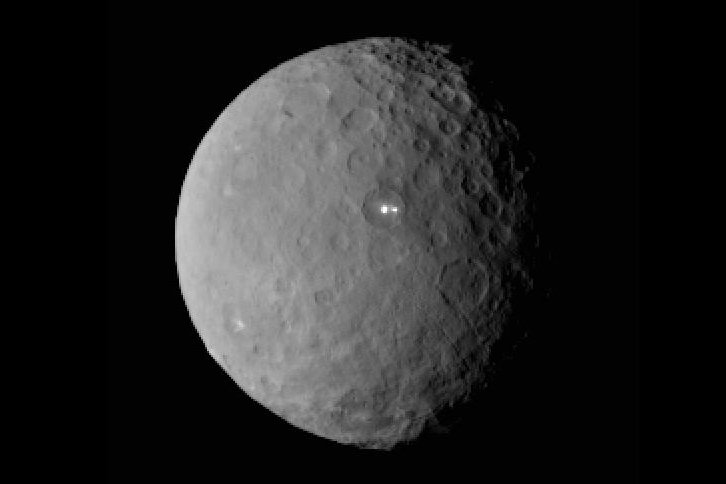1 of 2 | Ceres' two bright spots as captured by cameras on NASA's Dawn spacecraft. Photo by NASA/JPL-Caltech/UCLA/MPS/DLR/IDA
LOS ANGELES, Feb. 25 (UPI) -- It's been several weeks since scientists first caught a glimpse of a strange bright spot sparkling on the surface of the dwarf planet Ceres. But scientists back on Earth still don't have an explanation.
Now, newly released images -- captured by NASA's Dawn probe -- show the bright spot is actually two round splotches of reflected light, side by side, one slightly brighter than the other. The two eye-like headlights seem to be shining out from the pit of one of Ceres' craters.
"Ceres' bright spot can now be seen to have a companion of lesser brightness, but apparently in the same basin," explained Chris Russell, principal investigator for NASA's Dawn mission, based at UCLA.
"This may be pointing to a volcano-like origin of the spots, but we will have to wait for better resolution before we can make such geologic interpretations," Russell added.
While Dawn continues to beam back better and better images, it's still too early for NASA scientists to make any definitive determinations on the origin of the bright spots.
The latest photos were taken on Feb. 19, when the probe was still 29,000 miles from Ceres. Dawn will enter into orbit around Ceres on March 6.
"The brightest spot continues to be too small to resolve with our camera, but despite its size, it is brighter than anything else on Ceres," said Andreas Nathues, leader of Dawn's camera team, which is based at the Max Planck Institute for Solar System Research in Gottingen, Germany. "This is truly unexpected and still a mystery to us."
Still, the favorite explanation remains the same -- ice. Previous research has uncovered evidence of water vapor rising from Ceres' surface, and scientists believe Ceres' interior may be liquid water.
Ceres is one of five dwarf planets or protoplanets, a category that includes Pluto. It is also the largest body traveling in the asteroid belt, which occupies the real estate between the orbits of Mars and Jupiter.















